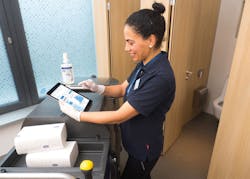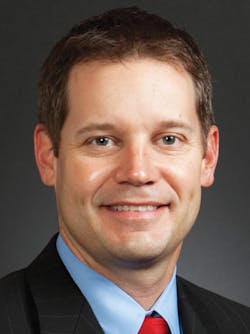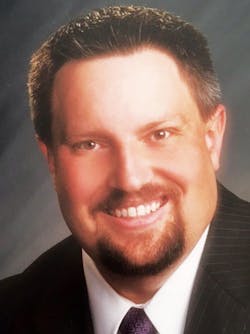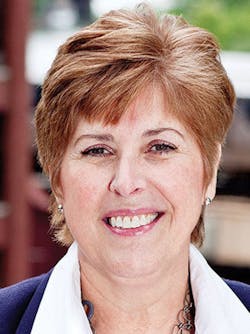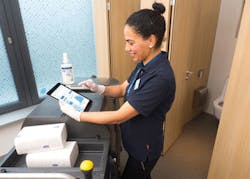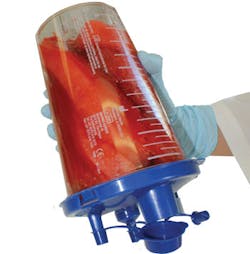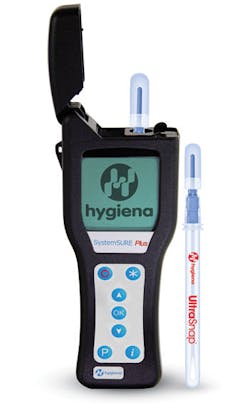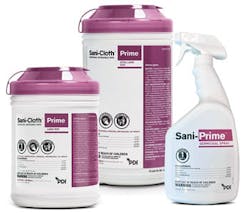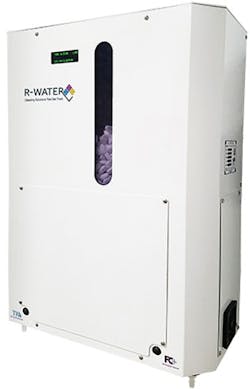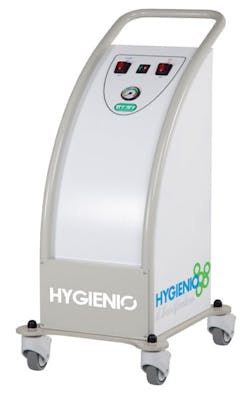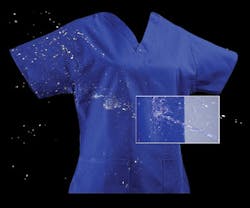Most healthcare facilities have realized by now that running a hierarchal system, with different departments laboring separately in silos, doesn’t work very well in a value-based care environment. Organizations that are serious about reducing infections, readmissions, reimbursement penalties, and staff turnover know cooperation, teamwork, inclusivity and transparency are essential tenets to follow. This means, for a growing number of environmental service (EVS) departments, the time has finally arrived for them to feel genuinely welcomed and needed at the table for expert insight on how to keep the healthcare environment clean and safe.
One hand washes the other
Mike Lamoreaux, Environmental Sup-port Services Director, Intermountain Healthcare, says the pressure to work faster hasn’t lifted and may in fact be increasing. “The rapid volume units such as emergency rooms, same day surgery, observation units and clinics seem to be the biggest issue,” he said. But, and this is key, Lamoreaux says authentic respect and teamwork among EVS, surgical staffs and Infection Preventionists (IPs) have improved immensely. “I have been in EVS for over 15 years and we have never had better relation-ships with our IP teams and clinical teams,” he said. “They are seeing EVS more and more as a strategic partner in patient safety and the patient experience and look to EVS to be the content expert when it comes to cleaning and keeping the environment clean and safe for patients. I think the role of our EVS teams is ever-growing and developing and being seen as an expert. It has been so beneficial to our teams to be seen as a partner and a player at the table rather than just some-one who is in their way. It is an exciting time to be a part of EVS and to partner closely with other leaders throughout the system.”
During the 45th annual conference of the Association for Professionals in Infection Control and Epidemiology (APIC) earlier this year, HPN noticed a sharp increase in the number of IPs seeking EVS-specific education and information about products and services. They also expressed appreciation for EVS and an eagerness to work more closely with these professionals to achieve better outcomes. “IP relies heavily on knowledge from EVS leaders to recommend the best products to use in their facilities,” said Jones. In addition, Supply Management relies on EVS leadership for product/equipment recommendations. The list can go on and on to new building designs, fabrics, flooring, traffic flow of EVS carts, trash carts, dock planning, recycling initiatives, etc.”
Certified and credible
As certification becomes increasingly more common and even required for sterile processing professionals, the environmental services profession is also taking the path of voluntary education and demonstration of competencies to stay ahead of changes.
Last year, the Association for the Health-care Environment of the American Hospital Association partnered with The Ohio State University to create the first academic certificate program in healthcare environmental services. The undergraduate program, available mostly online, falls under Ohio State’s hospitality management curriculum and covers relevant topics in microbiology, epidemiology and infection prevention, and patient experience in healthcare. It also offers a healthcare environmental services internship.
The first course at Ohio State took place during the 2018 spring semester with 44 students enrolled, according to the course developer Milos Bujisic, Assistant Professor, Department of Human Sciences. He says the course materials for the next class, Customer Experience in Healthcare and Hospitality, are being updated based in part on student feedback and will be available this fall. “We had very positive feedback for the course,” Bujisic said. “Especially environmental services professionals that took the course; they were very satisfied with the content.”
Top products that EVS professionals use to fight microbes
Here is a sampling of EVS technologies for cleaning and disinfecting the healthcare environment.
Clorox Healthcare
Clorox Healthcare VersaSure Cleaner Disinfectant Wipes are Environmental Protection Agency (EPA) registered to kill 44 pathogens, including bacteria, viruses and fungi, in two minutes or less. The low odor, low residue formula features patented technology that enhances quat activity on surfaces to deliver broader efficacy and faster kill times without co-actives. The formula is designed for staff and patient comfort with no harsh chemical fumes or odors. Durable, low-linting wipes are textured for greater strength. Excellent wetness provides greater surface coverage compared to some quat and quat-alcohol disinfectant wipes and assurance that treated surfaces will remain wet for the full contact time. “Not all disinfectants are created equal and many don’t have the optimal balance of attributes to meet users’ needs. For example, a conventional quat or alcohol-based product might offer good compatibility, but have limited kill claims or evaporate from surfaces before meeting the required contact time,” says Brian Thompson, department manager — R&D, Clorox Healthcare. “We believe healthcare facilities shouldn’t have to make those trade-offs and with VersaSure, they don’t.”
Essity Professional Hygiene
Tork EasyCube facility management software is a data-driven cleaning solution that uses sensors placed in facilities that measures traffic and alerts staff of refill supply levels in real-time. EVS teams are able to work proactively and address exactly what’s needed, when and where it’s needed, to improve efficiency and accuracy. “Many facilities have vast campuses, with multiple lobby, breakroom and restroom areas in addition to patient rooms. Managing these public spaces can be a challenge with limited cleaning staff, whose first priority is maintaining a hygienic environment in patient rooms,” said Tom Bergin, Healthcare Segment Director, Essity Professional Hygiene. “Cleaning staff are confident that every task matters, boosting their productivity and job satisfaction,” he added. “With higher visibility to supply use, replenishment can be adjusted to ‘just-in-time’ purchasing eliminating the challenge of inventory control, storage and monitoring. In addition, digitized cleaning plans make pulling daily, weekly or monthly quality assessments seamless for adjusting staff scheduling and allocated resources. With the 20 percent reduction in labor hours, staff can be redirected for greater efficiency, which benefits everyone’s bottom line.”
Hygie
“We realized that moving suction canisters from patient rooms and operating theaters could present a hazard to environmental services workers with some canisters opening, spilling or biohazard bags leaking,” explained Hygie’s Export Director Emanuel Couture-Armand. “In a typical case, an environmental services worker or someone cleaning hospital rooms would detach a suction canister, bring it to the soiled utility room and put it in a yellow biohazard bag. There are a few dangerous elements amongst that chain where the canister can leak upon removal, can spill upon transport and can leak in the biohazard bag/container. With the absorbent stick used, we can eliminate that possibility and limit the proliferation of bacteria as everything is absorbed and solidified by the stick, hence nothing can spill and bacteria are contained. Also, when it’s turned into gel, it can change classification and not be thrown in ‘biohazard’ which can reduce waste costs dramatically. We even saw some legislations making mandatory the solidification (i.e., turn into gel) of fluids disposed in patients’ procedures. The Hygie super-absorbent stick can be effectively used in negative pressure therapy system, gastric drainage, surgery, disposable medical containers, disposable urinals, emesis basins, and bedpans, and biohazard bags. Any purchasing cost is easily offset and turned into savings with this product. We welcome questions, tests and can supply free samples for trial and value analysis.”
Hygiena
According to CDC recommendations, an objective measurement tool for monitoring cleaning thoroughness should be conducted and can be accomplished using a number of products such as direct practice observation, swab cultures, agar slide cultures, fluorescent markers, and ATP bioluminescence. “Based on industry experience, ATP testing is one of the most commonly implemented methods because it is the only method that combines quantitative data collection with scientific measurement, while delivering real-time results,” said Sergei Lepeshinski, Eastern Regional Sales Manager, Hygiena. “The Hygiena SystemSURE Plus ATP monitoring system helps facilities establish their own cleanliness baseline. Furthermore, consistent hygiene monitoring allows facilities to make sure that their internal cleaning standards do not deviate from an established baseline. EVS teams put tremendous efforts into cleaning and constantly strive to demonstrate continuous improvement. By utilizing a real-time, real data testing method (ATP testing), EVS teams are able to identify issues quicker and take necessary steps not only towards correcting the issues but also preventing them.”
PDI
“Sani-Prime disinfectants’ proprietary ACCELOQUAT formulation provides a rapid 1-minute kill time on over 50 microorganisms allowing for quick room turnover. It also is compatible with commonly used materials found in healthcare, supporting positive user experience,” asserted PDI Product Manager Allison Buldo. “The strong, textured applicator of Sani-Cloth Prime Germicidal Disposable Wipes cleans as it disinfects to further aide in the removal of bioburden and overall efficiency. Sani-Prime Germicidal RTU Spray has the same broad-spectrum efficacy against top HAI-causing pathogens. A true 1-minute bactericidal, virucidal, fungicidal, and tuberculocidal, it is also compatible with commonly used materials found in healthcare. These key features make it a valuable investment for patients, staff and facility alike.”
R-Water
The R-Water TK-60 disinfecting solution is created onsite in a machine that is hooked to a water line, filled with pure salt and plugged into a standard wall outlet. A patented internal electrolysis process creates one solution for routine cleaning and sanitation and another for heavy disinfection. EVS teams fill buckets and sprayers right from the equipment to create a one-step healthcare-grade product with a 1-minute contact time that kills C.diff spores. “We have adopted this technology for all facilities of Cuero Health because R-Water addresses the need for disinfection and cleaning, while reducing chemical exposure to our patients and the environment,” said Gary Loftin, Director of Integrated Facilities Management for HHS (Hospital Housekeeping Systems) and Cuero Health. There have been zero hospital-acquired infections at Cuero Health due to the cleaning process since R-Water was adopted in February 2017. “Once the word gets out hospitals will be racing to install R-Water throughout their facilities,” said Tom Derrick, Co-Founder, Senior Vice President, OpenMarkets.
umf Corporation
Micrillon is a first-of-its-kind rechargeable broad-spectrum antimicrobial polymer (plastic) additive that will help reduce the spread of drug-resistant infections and preventable hospital associated infections. Added during the raw material stage, George Clarke, CEO, says the first product to be introduced is the patent-pending C-Pull hand-hold for privacy curtains used in hospitals, long term care and nursing homes. “Micrillon is unique in that it is antibacterial, antifungal, antiviral and permanent. It does not leach out of the product into the environment,” said Clarke. “Micrillon rechargeable high-touch surfaces effectively minimize this risk. Trials that will result in case(s) for the C-Pull are currently being implemented. Third party laboratory testing has been done which demonstrates excellent results against both gram-negative and gram-positive bacteria, virus and fungus.” Micrillon also can be added to polymer film, acrylic latex paint and manmade synthetic polymer fibers.
Quality Processing Resource Group LLC
Using dry, low-temperature steam from distilled water, the Hygienio system delivers liquid disinfectant of your choice to all room surfaces, including soft surfaces such as drapes and mattresses. It also reaches hidden, shadowed, and other hard-to-reach places and requires no wiping, which means no waiting. Disinfected areas can be accessed within minutes after application. The stainless-steel delivery system is compatible with all disinfectants including alcohol disinfectants of up to 70 percent concentration, hydrogen peroxide, peracetic acid, quaternary ammonium compounds, and other FDA/EPA-cleared disinfectants. Disinfectants are applied via steam gun which allows users to disinfect easily the tops of surgical and examination lights, booms, lower portions of examination and surgical tables, the tops of OR lights, and other underneath surfaces.
Vestagen
EVS technicians in healthcare facilities work in extremely tough conditions. Their jobs routinely expose them to splatters and spills of contaminated fluids like blood, urine, vomit, sputum, hazardous waste such as used needles, tainted linens and dangerous cleaning chemicals like bleach. VESTEX active barrier apparel is the first and only apparel that has received 510(k) clearance from the FDA that is designed to protect healthcare workers by repelling fluids that EVS staff get exposed to and reduces the retention of MRSA on the staff’s apparel, both at the beginning and end of the work shift. This is important because you want to minimize the risk of workers being contaminated with either fluid stains or MRSA and going from room to room throughout the day, nor do you want to risk having them take any potential contaminates from the hospital to their families at home.
EVS Vendor Listings
About the Author

Valerie J. Dimond
Managing Editor
Valerie J. Dimond was previously Managing Editor of Healthcare Purchasing News.
